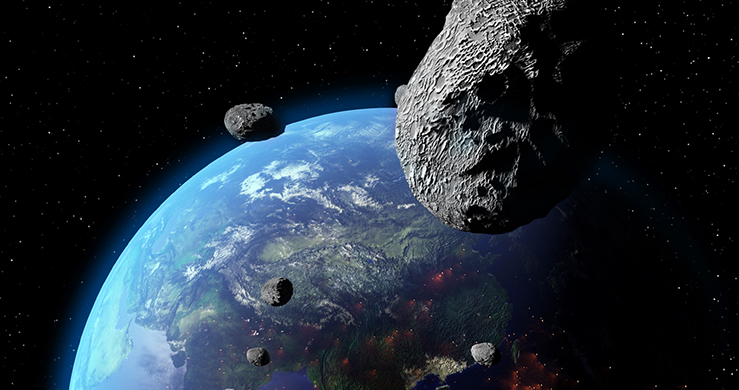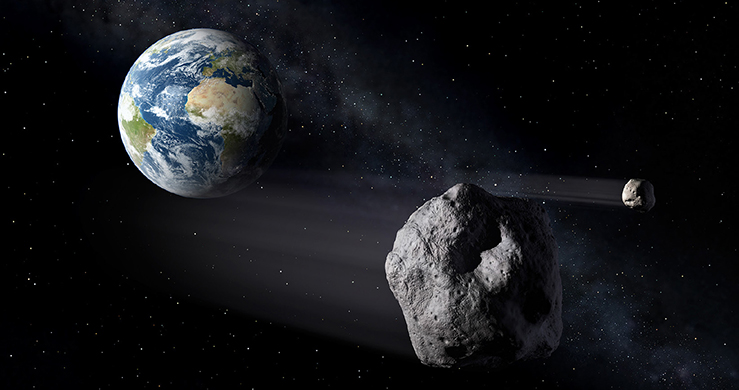ESA’s asteroid risk assessment
Asteroids are ancient material left over from the formation of the Solar System, thought to have brought complex molecules and possibly early life to Earth, billions of years ago.
Impacts from large asteroids like Chicxulub are incredibly rare, but small- and medium-sized rocks are far more common in the Solar System and can still do serious damage.
We currently know of well over half a million asteroids in our Solar System. Of these, over 25 000 are near-Earth objects (NEOs), over 1000 of which are in ESA's risk list as of 2021, meaning that they merit close follow-up observations.

ESA’s Planetary Defence Office
ESA's Planetary Defence Office is an essential element in the Agency's space safety activities. The goals of the Office are to:
- Radar and optical measurements and their simulation
- Become aware of the current and future position of NEOs relative to Earth
- Assess the consequences of any possible impact
- Develop interfaces for informing relevant parties such as national emergency response agencies of a possible impact
- Develop methods to deflect any potentially dangerous asteroids
The Planetary Defence Office conducts regular observation campaigns to look for potentially dangerous NEOs, predicts their orbits, produces impact warnings when necessary and is involved in potential mitigation measures. The office divides its work into three areas:
1. Observation
In order to become aware of the current and future position of NEOs, we need telescopes scanning the sky for potentially hazardous objects.
The Flyeye telescope
Every night, ESA’s planned network of Flyeye telescopes would scan the skies for asteroids, automatically flagging any that pose an impact risk and bringing them to the attention of human researchers.
Similar to the technique exploited by a fly’s compound eye, these bug-eyed telescopes split each image into 16 smaller subimages, increasing the total amount of sky that can be observed and expanding the ‘field of view’.
By placing one in the Northern and one in the Southern hemisphere, the entire sky will be scanned within 48 hours. Simulations have shown that about four asteroids larger than 1 meter can be detected every year before they will impact on Earth.
Test-Bed Telescopes
Two 56-cm Test-Bed Telescopes (TBTs) will be primarily used to test the data processing currently being developed for the Flyeye telescope. One telescope in located at ESA’s Cebreros Deep-space ground station in Spain and its twin is located at La Silla in Chile, installed on site at ESA’s partner organisation, the European Southern Observatory.
Optical Ground Station
ESA's Optical Ground Station in Tenerife is equipped with a 1 m-diameter telescope and is the major optical facility used by ESA to follow up asteroid observations. It is typically used for four nights around new Moon for NEO observations.
Sponsoring European observations
ESA also sponsors other national telescopes in Europe, like the Klet observatory in the Czech Republic and telescopes in Tautenburg, Germany, and Spain. The Agency also works alongside the 0.8m Telescopi Joan Oró in the Spanish Pyrenees, the 0.6m Observatoire des Makes, at Saint-Louis on Réunion Island, and with the International Scientific Optical Network (ISON).

2. Data Provision
Data on near-Earth objects and risky asteroids is collected from telescopes and radar systems worldwide. ESA's Near-Earth Object Coordination Centre (NEOCC), based at ESRIN in Frascati, Italy gathers measurements collected by the Minor Planet Center, which is operated with the help and support of the International Astronomical Union (IAU) at Cambridge, Massachusetts, USA.
The NEOCC’s aim is to contribute to and coordinate observations of small bodies in the Solar System – such as asteroids, comets and even minor planets – and to evaluate and monitor the threat posed by any that come near Earth.
Europe has conducted thorough studies of this approach (e.g. Don Quijote concept), which would be suitable to address the statistically most common threats, namely of bodies of up to a few hundred meters in diameter.
3. Mitigation
If an asteroid is deemed potentially dangerous, emergency response agencies across the globe are informed of the impact risk and given support and advice from the NEOCC and other organisations. Evasive action on the ground may be necessary for smaller asteroids. The Planetary Defence Office is working on the following measures for larger ones:
The fireball camera
A space-based fireball camera is being developed by ESA, along with tools to simulate impacts, their effects on Earth and investigate deflection techniques.
Hera Mission
ESA’s planned Hera mission, named after the Greek goddess of marriage, will be humankind’s first probe to rendezvous with a binary asteroid system – a little-understood class making up around 15% of all known asteroids.
Hera is the European contribution to an international double-spacecraft mission called AIDA. NASA will first crash its DART spacecraft into the smaller of the two bodies, ‘Didymoon’, modifying its orbit around the primary asteroid, ‘Didymos’, by a small amount. Hera will then follow-up with a detailed post-impact survey that will turn this grand-scale experiment into a well-understood and repeatable planetary defence technique.
Hera will gather crucial scientific data, helping scientists and future mission planners better understand asteroid compositions, structures and behaviours in response to a kinetic impact.